On the Brink
In the Horn of Africa, a climate-fueled food catastrophe looms.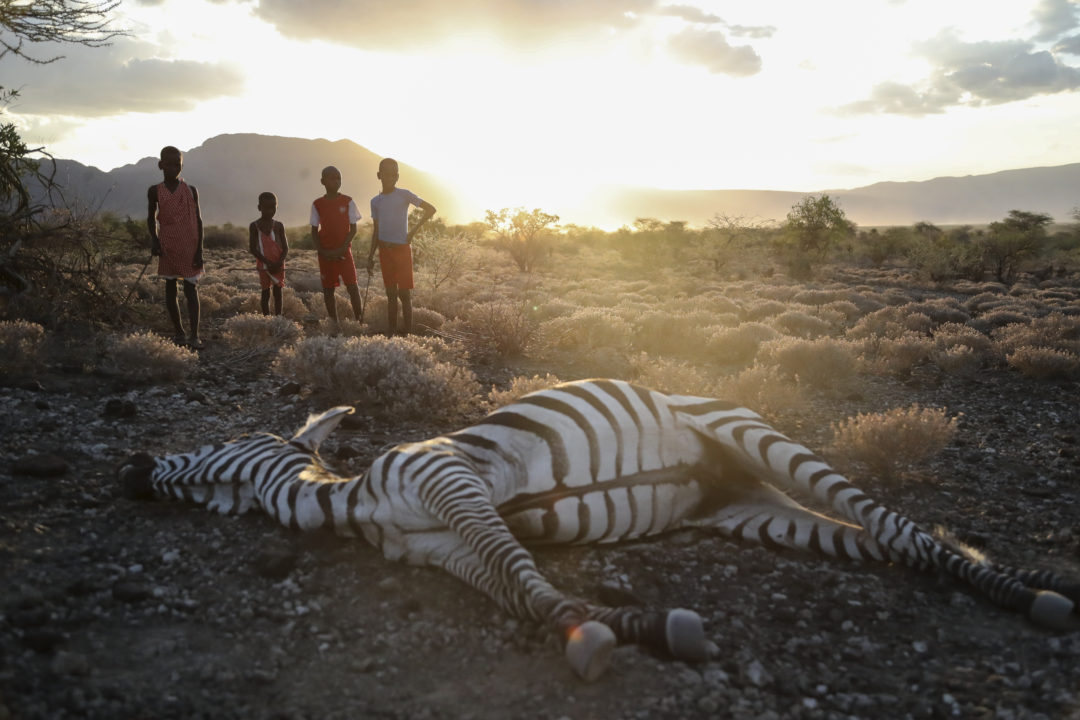 Maasai children stand beside a zebra that local residents said died due to drought, as they graze their cattle at Ilangeruani village, near Lake Magadi, in Kenya. Photo: Brian Inganga / AP.
Maasai children stand beside a zebra that local residents said died due to drought, as they graze their cattle at Ilangeruani village, near Lake Magadi, in Kenya. Photo: Brian Inganga / AP.
This story was originally published by Inside Climate News and was supported by the Pulitzer Center on Crisis Reporting.
In Torchia, Kenya, if there’s a ring around the sun, it will rain. If the gude bird sings in descending notes, the skies will open. If vultures gather, the showers will begin. Everyone reads the signs, but they don’t mean what they used to. It’s still not raining.
Jala Barako is 85, a grandfather of eight and a member of an ancient nomadic tribe. Today, wearing a pinstriped jacket, dark glasses, and a turban-like hat, he looks like the proprietor of a progressive jazz club. He sits outside a metal-walled shed that serves as the village store — the place where people come to buy provisions before heading out into this Martian-rocked landscape with their livestock to find pasture again. For generations, Barako explains, his people have slaughtered goats to read the weather forecast spelled out in their wet entrails. Now the readings are all off.
“The climate is changing,” he says, with a fatalistic laugh. “Even in the intestines.”
Consistent, gentle showers over days and weeks replenish the shrubs and grasses that livestock depend on here. But it hasn’t rained steadily for two, going-on-three years, and there’s nothing green in sight.
The government has drilled boreholes, but there aren’t enough of them. Herders have to travel long distances to reach the water and then equally long distances to find any remaining pasture. Where there’s water, there’s no pasture and where there’s even the scantest bit of uneaten pasture left, there’s no water. On the trek between one place and the other, animals crumple from exhaustion and die.
“We depend on livestock, and the ones that haven’t died are so weak,” Barako says. “In normal times, they support us. Now we support them.”
Livestock here are the primary source of income and nourishment. When they die, the people come next.
Near the village shop, relief workers from a local aid group called PACIDA distribute corn, beans, cooking oil, salt, and sugar. A water truck is scheduled to come soon, too, but international aid has lapsed, so it will be the last for a long time.
“Even with this they won’t get a meal every day,” says Adano Salesa, a program officer with the group who is in charge of distributing the food to each eligible person. Only the most vulnerable get a share.
“If there is no more help,” he says, methodically consulting a checklist, “people will die.”
Nearly 26 million people in the Horn of Africa are facing extreme hunger, with some areas already reaching catastrophic famine levels, according to the United Nations. The situation here is unfolding as a food crisis threatens a record number of people around the world, with nearly 345 million at acute levels of hunger and nearly 50 million people on the brink of famin
“We are on the way to a raging food catastrophe,” U.N. Secretary General António Guterres tweeted recently.
This year’s droughts and severe weather diminished or decimated crops across the world — in parts of the United States, Europe, China, Australia, and the Indian subcontinent.
The current emergency foreshadows what researchers call “multiple breadbasket” failures, which will likely occur more often and with greater intensity as Earth’s atmosphere warms. Battered by more climate-induced weather shocks or chronic conditions like drought, the world’s farmers are projected to produce less food in coming decades as the global population rises toward 10 billion.
“There are other drivers of food insecurity,” said Francesco Tubiello, a senior statistician at the U.N.’s Food and Agriculture Organization, or FAO. “But those related to climate change will increase and become more and more important.”
For decades, researchers have warned of the impacts, mostly negative, that climate change will have on the world’s staple crops. But the recent spike in hunger and famine are revealing the instability of a global food system that is ill prepared for shocks, whether from war, pandemics, severe storms, or drought.
“It’s hard to look at the global agri-food system right now and say this is working,” said William Boyd, a professor at UCLA’s Institute of the Environment and Sustainability. “Putting climate disruptions on top of it just creates more stress.”
The global food supply is dependent on four major grains and vast quantities of fertilizer. Much of this is controlled by a handful of corporations and exported by a few countries that dominate production. Over decades, the movement of these grains and fertilizers across borders has created a vast globalized trade network in which many countries are dependent on a few. Grain traders, shippers, and speculators in this interconnected food economy often make big profits off disruptions in the market, driving up prices and putting food out of reach for millions of the world’s poor.
“There’s a concentration of crops, a concentration of countries, and a concentration of companies,” said Jennifer Clapp, vice chair of the High Level Panel of Experts for the U.N. Committee on Food Security. “And then there’s the fourth C in this equation, climate. With climate change we’re much more likely to see uncertainties and disruptions. If anything happens to one of those crops — a global blight — or any of those countries has a disaster, it can make the global markets go crazy, and that creates high prices.”
The price spikes don’t just affect individuals. The U.N.’s World Food Program, or WFP, the world’s largest humanitarian organization, is facing major shortfalls, with only about half of the money it needs to get food to millions of hungry and dying people. The prices the organization pays for food have risen from 30 to 50 percent since the beginning of the year. The cascading effects of climate-related disasters are exposing an already strained humanitarian system that is unprepared to handle repeated or simultaneous disasters.
“These countries in the Horn of Africa may seem isolated, but from a food perspective, they’re part of a global food system,” said Lifeng Li, director of the land and water division at the FAO. “The challenge they’re facing is the challenge we’re all facing. It could happen to us.”
Some experts believe what’s happening in the region could become the worst humanitarian disaster in a generation — despite all the improvements in early warning systems, the awareness-raising global rock concerts of the 1980s, and the “lessons learned” from the famines of recent history.
“With climate change, the system is at a breaking point,” said Gernot Laganda, who leads climate and disaster risk reduction efforts at the WFP.
A frame of bones, too big to be a donkey or cow: a camel carcass, its orange-white ribs poking out of the sand after weeks in the sun.
As the two-lane A3 road leads northeast out of Nairobi, the city thins out into squat concrete apartment buildings and megachurches, then pineapple farms and mango groves. Like most highways, it’s lined with motoring essentials: gas stations for refueling and quick-stop restaurants for truck operators.
But as it heads into the arid north, the highway is as much a conduit for water as an artery for fossil fuels.
On both sides of the road, donkeys’ backs are piled high with sun-bleached jugs, each filled with 20 liters of water. They carry the jugs along brick-red dirt paths that line the highway on both sides, in an endless slog to retrieve water from one place and bring it to another.
Where the Tyaa River intersects with the highway, there’s a meandering beach—a winding course of sand that should be filled with water at this time of year. Instead, the heads of workers pop up from the riverbed and disappear again into holes dug deep enough to reach the water table.
“Since the rains have failed, the river has disappeared, and it’s difficult to fill the containers,” said Abel Chalo as he ladled water from a shallow pool of water the size of a serving platter. “We used to draw 200 liters. Now it’s not even possible to draw 50 in a day.”
The arid and semi-arid lands, or ASALs, of Kenya begin roughly in the country’s midsection and stretch north past its borders into Somalia, Ethiopia, and South Sudan. The green highlands of Nairobi, with their electric purple flashes of jacaranda trees and lush gardens, feel like another planet.
The red earth here turns into an endless stretch of dun, with thorny needled shrubs and flat-topped acacias that seemingly stopped growing upward, resigning themselves to the wind over thousands of years. There are fewer and fewer donkeys as the road stretches north.
Emerging from a brambly brush at the side of the road, Halima Ismael and her mother-in-law carry yellow water jugs and rolled blankets for their trek to a faraway watering hole. “We used to use donkeys to get the water, but the donkeys have all died,” Ismael says. “We’re going for the water ourselves.”
Farther north, camel caravans start appearing at the roadside as they travel to points for their weekly watering. And then odd shapes also begin to appear.
A frame of bones, too big to be a donkey or cow: a camel carcass, its orange-white ribs poking out of the sand after weeks in the sun. Down the road, another camel that recently collapsed, an eye pecked out by birds already, with fresh blood still pooling in the socket.
In Marsabit County, to the west, a sandy track crosses a maroon rockscape that meets the horizon in every direction. Empty plastic bottles glint under the sun. Mere yards separate one pile of camel bones from the next.
“If the camels die, that’s the end of everything,” said Patrick Katelo, PACIDA’s director. “Even these animals cannot make it now.”
Thousands of miles from the Tyaa River, in a Mussolini-era building in Rome, FAO’s Li spends his workdays pushing for countries and governments to take water more seriously. He notes the absence of ministries of water in any country he can think of.
“Food is water,” he says. “Ninety five percent of the food we eat is produced on land. Water is the media where we’ll feel the impact of climate change.
“Sure, there will be heat waves. But there will be too much water. Too little water. Water at the wrong time. Water in the wrong place.” He points to recent flooding in Pakistan and to a drought in Italy itself that forced the government to declare a state of emergency over the summer.
“It has to be a priority,” Li says.
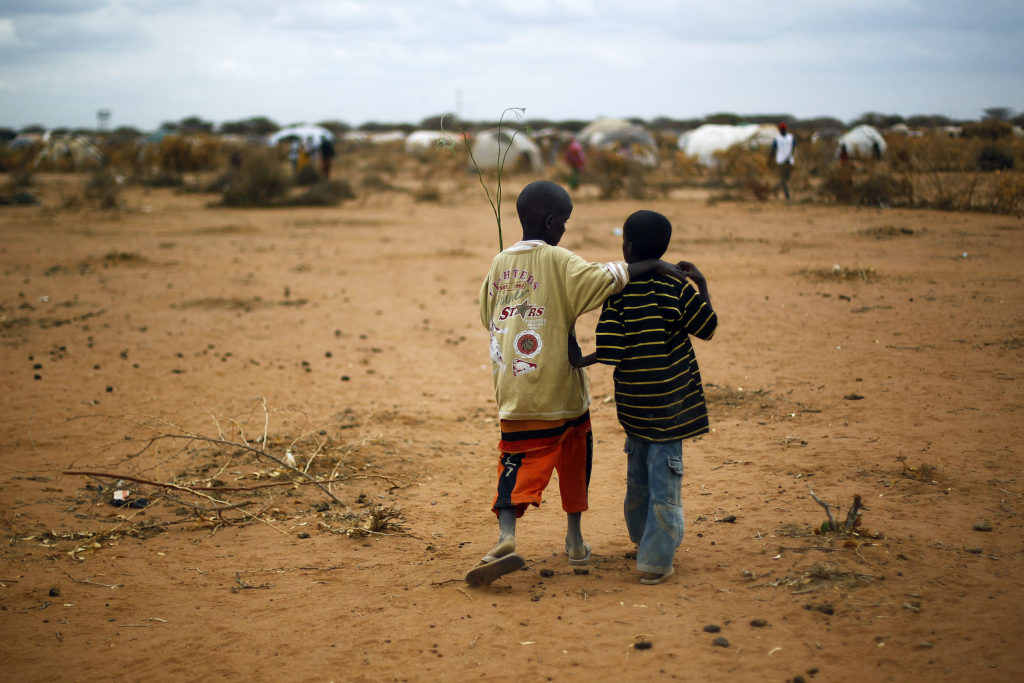
Butali Ali has lived in her new home for five days, half the time it took her to travel here from Somalia across a parched, scrubby plain on a donkey cart with her husband and childr
Her house is a patchworked tent of bent branches covered in scarves, old T-shirts, and plastic tarps from the United Nations. Thousands of these makeshift domes are sprouting up across the sand as more people stream south from Somalia into northern Kenya.
“Life was terrible there,” Ali says, her baby wailing in her arms. “There is no food. All the animals have died. And if the animals have died, the people will die.”
Since the beginning of the summer, at least 45,000 people have fled to this refugee camp, in Dadaab, in the northeastern corner of Kenya about 60 miles from the Somali border. They are coming so steadily and in such numbers that the Kenyan government has yet to count them all. Ali and her family are not even official yet.
For decades, their country has been torn apart by civil war. They’ve lived in constant terror of the militant group Al-Shabaab, which has ripped apart villages and murdered thousands. But something else finally pushed these Somali refugees out of their homes and into the unknown: They’ve given up hoping for rain.
“We were optimistic,” Ali says, explaining what kept her from fleeing sooner. “But it hasn’t rained in years.”
Of the 26 million people in the Horn of Africa who are facing severe hunger or famine, 4 million are in the northern part of Kenya — a middle-income country that, unlike neighboring Somalia and Ethiopia, is not riven by war or unrest. Here, it is climate change-induced drought and scorching heat, not conflict, that has left millions on the edge of famine.
Droughts and famines in the Horn of Africa have killed at least 3 million people in the past 50 years. It’s a chronically dry, famine-prone place. But the parched, heated conditions now are being amplified by warm air currents carried from greenhouse gas-heated waters thousands of miles away in the Indian Ocean, and the droughts are occurring with greater severity and more often, leaving people and animals insufficient time to recover.
This part of Africa, which relies on two rainy seasons, has not seen adequate rain for five seasons running. Meteorologists and climate scientists are predicting a sixth below-average rainy season next spring, which would mean rain has not fallen reliably or adequately for three straight years.
“This is unprecedented,” said Rupsha Banerjee, a drought and livestock expert with the International Livestock Research Institute in Nairobi.
In Kenya, home to two of the world’s largest refugee camps, people fleeing countries to its northern region are taxing resources in the communities where the camps are situated, sparking conflicts over already stretched resources. In some areas, farmers are fighting with herders who are encroaching on their land in search of pasture for their animals. Grisly revenge killings of both people and livestock are becoming a regular occurrence.
The situation here, experts say, is a microcosm of what happens when climate change shifts patterns that humans, animals, and plants have relied on for centuries and millennia.
“In the Horn of Africa, you have a triple whammy,” said Tim Benton, who leads the environment and society program at the London-based think tank Chatham House. “Another year of bad weather, high food prices, and the high costs of shipping, and high prices mean less food aid.”
“All of that has the potential to destabilize the region, with greater migrant flows and more pressure on neighboring countries,” he said. “It’s not just starving people in Africa we should be worried about, it’s the consequences for conflict.”
For Ali and millions like her, the forces behind her suffering are abstract and distant notions. But for officials overseeing aid to refugees, there is a direct line between the behaviors of rich countries, which are largely to blame for climate change, and her family’s misfortunes.
“These are communities that have contributed nothing to climate change, but they’re the ones staring, literally, into the face of the climate crisis,” said Gemma Connell, who heads the southern and eastern Africa regional office of the U.N’.s Office for the Coordination of Humanitarian Affairs. “It’s just devastating to see people who’ve done nothing go through this.”
All anyone talks about here in Marsabit County is the lack of rain. On a recent federal holiday, newscasters and pundits lamented that there was little to celebrate, given that 4 million people in 23 of the country’s 47 counties were on the brink of starvation. In Marsabit, Kenya’s largest county, one in five people is going hungry.
“My greatest fear is the loss of life in the coming days and months,” says Immaculate Mutua, the county’s nutrition coordinator, sitting at a chipped conference table in the county health department. “We’re just hanging on a cliff. Starvation is already happening. It’s not a worry for tomorrow. It is here.”
Even in countries where war isn’t thwarting help, organizations often find that they have to compensate for a local government’s lack of infrastructural development or poorly funded social safety networks
Kenyans and humanitarian aid workers refer to the town simply as Dadaab, but the refugee camps here have names: Hagadera, Ifo, Dagahaley. They have become permanent cities, with schools, mosques, shops, healthcare clinics, and hospitals.
To reach Ali’s home in the Dagahaley, you pass an endless warren of homes built over the decades, gravesites surrounded by thorny fencing, and the razor-wire compounds of aid groups where the wind builds sweeping dunes of plastic bottles.
Past all of this is the camp’s edge, where fresh arrivals build their new shelters. The perimeter of the camp expands every day.
So far, no official help has arrived. Not from the Kenyan government or the U.N., which jointly run the camp. The only help Ali has received at this point is from fellow refugees who share tea or food and the odd bit of wood or clothing. “Well-wishers,” she calls them.
The refugee camps were established more than 30 years ago for people fleeing war in Somalia and at one time held claim to being the biggest in the world. (That title was later claimed by another camp, called Kakuma, in Kenya’s far northwest.) They are now home to hundreds of thousands of people — to generations.
“This is my section,” said Abdihakim Mohamud Abdi, 15, wearing his school uniform. “I was born on this block.”
The Kenyan government has an uneasy relationship with the camps and has called for closing them, citing security concerns. But they have become the economic backbone of an otherwise inopportune place. The main dirt strip through Dadaab has a couple of small hotels and a handful of restaurants and shops. While the people in this region are nomadic, the refugee infrastructure has created a fixed point.
“We have come to like the camps because they support business,” said Hussein Jamma, manager of the Hanshi Palace Hotel on Dadaab’s main road. “It would be bad if they closed.”
Still, the drought is testing that alliance. Hunger rates are rising in the nearby settlements, and livestock are dying by the millions. Some of the locals, mostly pastoralist herders, are now going to the refugee camps to seek help.
“Even the host community is suffering,” said Mohamed Idris Moge, a teacher at one of the refugee schools. “Thirty years ago these communities had a lot of resources — trees, water. But they’re clearing all the trees. This place was a forest.”
It is also a home now. “I don’t want to go back to Somalia,” Ali says, echoing the sentiment of so many of her new neighbors.
Then the wind scurries up some sand. Clouds gather in the blue sky. Nothing comes from them today, or the next day, or the next.
Inside his office at the WFP in Rome, Laganda takes a marker to a dry-erase board.
He draws one line ascending at 45 degrees. “These are our needs,” he says, then draws another line at about 5 degrees. “These are our funds. This is the shape of our problem.”
Laganda’s office, off a zigzagging corridor in the agency’s sleek energy-efficient headquarters, is a testament to his own energy, with diagrams written on yet more dry-erase boards, marathon race bibs tacked to the wall, and a massive tangle of lanyards from what looks to be every climate-related conference in the last decade.
Downstairs in the building’s lobby, past the heavy security entrance, hangs the Nobel Peace Prize awarded to the World Food Program staff in 2020 for its efforts to relieve hunger and to prevent hunger from being weaponized by governments against their own people.
“We believe food is the pathway to peace,” reads a quote from the program’s executive director, David Beasley, in big brassy letters on the same wall.
But scary numbers are staring everyone here in the face. The WFP, the world’s largest and most influential humanitarian aid organization, currently has half the financing it needs to get food and aid to hungry people, even with a recent infusion of $1.3 billion from the U.S. specifically earmarked for Horn of Africa countries.
The current deficit isn’t all climate-related. But in the countries that the program considers the most at risk, drought or floods are either a factor or a major cause. In 2021, weather conditions were considered the primary driver of hunger in eight African countries, and Laganda expects that number will go up when the WFP does its analysis for this year.
The future looks equally worrying. The U.N. recently estimated that if the world continues to emit greenhouse gases at current levels and global temperatures increase by 4 degrees Celsius (7.2 degrees Fahrenheit), 1.8 billion more people will not have enough to eat. This year, the WFP expects to handle 160 million.
A relatively new term in humanitarian work is anticipatory action, which, as it sounds, means anticipating a food crisis before it happens and doing something about it. The concept depends on complex early warning systems that factor in weather, economics, conflict, and potential crop failures. Acting early, the thinking goes, will not only save more lives but also cost less.
But such efforts require money, coordination, and taking action—giving cash to people before a flood so they can afford to leave their homes or move their livestock to safety—and gaining access to often war-ravaged countries where crises are happening.
“It’s hard to push for anticipatory action when there are so many other crises going on,” said Brenda Lazarus, an economist who specializes in early warning systems at the FAO in Nairobi. “We know when a famine is coming. It’s how you link the warning to action, and funding is definitely an issue.”
Even in countries where war isn’t thwarting help, organizations often find that they have to compensate for a local government’s lack of infrastructural development or poorly funded social safety networks—and that’s when their own budgets are strained.
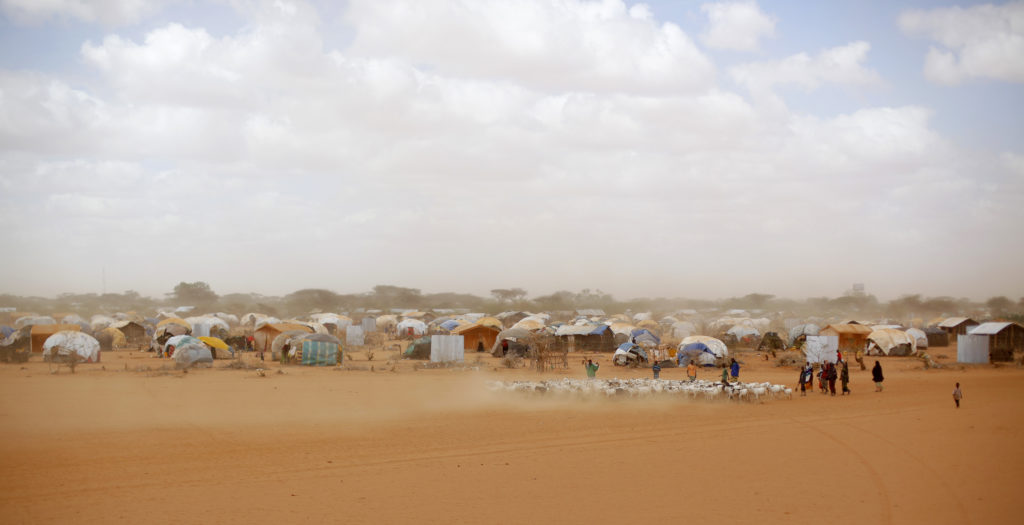
Amina Abdulla is a regional development specialist, based in Nairobi, with the aid group Concern Worldwide. Like many in the humanitarian field, she feels the government has essentially abandoned hunger relief efforts and given up on longer-term adaptation measures. In many cases, as in Kenya’s, the country itself is in debt and unable or unwilling to spend funds to shore up systems — like build more wells or improve roads — that would help people cope.
“Conditions deteriorate. The government does nothing. And then they just say: ‘Our international development partners will help,’” she said. “The humanitarian system, to some extent, is enabling the government to abdicate its responsibilities.”
Her colleague, Hassan Olow, adds: “In some communities, people think we’re the government.”
Already, big donors, including the U.S. — the largest contributor to global humanitarian aid — are contributing more than ever. Appeals for aid have shot up over the last year and are projected to grow. The tab will only continue to grow.
“As an American taxpayer,” Abdulla wondered, “is this what you want to do with all your dollars?”
The village of Kangichok in Turkana County is hundreds of miles northwest of Dadaab, but conditions are much the same. A cluster of women and girls sit under an acacia tree, bashing nuts from doum palms with rocks. Their pounding yields a tiny amount of fibrous material that tastes like barely sweetened shredded mulch. At night, the women feed it to their children with a little bit of water so it expands in their stomachs, to give them the sensation they’ve eaten
When asked what would help them the most, Veronica Ebei, her thin neck encased in a massive yoke of beads, stands up. “We require an emergency intervention,” she says, somehow cheerfully. “Or cash transfers.”
Across Turkana County, especially in the north, closer to the border with Ethiopia and South Sudan, the story is repeated in village after village. The animals are dead. The water points produce water that’s too salty or dirty to drink.
“The livestock are finished,” says Margaret Nanok, holding up a plastic bottle filled with coffee-colored water. “And we’re just scooping water from undug shallow wells.”
Nanok explains that she and the other women have to walk nine miles, to the base of a nearby hill, to collect water. “The whole day is wasted,” she says. “We have to leave the infants and children behind.”
The fears — of these pastoralists, of the government, of hunger relief groups — are becoming fact.
Gathered together in a village meeting, dozens of men and women sit on the dusty ground. Their calves are as thin as rolling pins.
Peter Siike says his wife died of hunger. But as he begins to talk, his son, embarrassed and angry, shouts him down and tells him not to speak about it. Siike looks down at the ground tearfully. “Nothing can be done for us,” he says.
With millions on the verge of famine, food security experts and advocacy groups used the talks as a platform to call for a broader and more fundamental overhaul.
Two thousand miles to the north, in the Egyptian resort town of Sharm el-Sheikh, government officials and negotiators from around the world gathered last month at the United Nations 27th Conference of the Parties, known as COP27, to gauge the world’s promises to cut greenhouse gas emissions. And there, as record-high hunger levels gripped the continent, discussions about food security inched closer to the forefront of the proceedings.
With 200 events focused on food systems and agriculture, four major pavilions devoted to food and one day dedicated to agriculture, some dubbed it the “Food COP.” The “implementation plan” that emerged from the conference prominently acknowledges food for the first time, noting “the fundamental priority of safeguarding food security and ending hunger, and the particular vulnerabilities of food production systems to the adverse impacts of climate change.”
Globally, food systems and farming contribute roughly one-third of the world’s total climate-warming gases yet at the same time are under serious duress from the effects of a changing climate. This year alone was a striking case in point, with droughts and floods across many countries, including the U.S., where drought in the Southwest and central Plains cut crop yields and forced ranchers to sell off livestock.
The COP discussions on agriculture focused on reducing its contributions to climate-warming gases, especially methane. More countries signed on to a year-old pledge to reduce methane, promising to devote more funding to helping farmers limit emissions of that potent greenhouse gas.
But, with millions on the verge of famine, food security experts and advocacy groups used the talks as a platform to call for a broader and more fundamental overhaul.
“The food security crisis, the repercussions of the drought in East Africa, are putting a very sharp point on the fact that our food systems are broken,” said Sara Farley, a vice president with the Rockefeller Foundation, which operated one of the food-focused pavilions at the COP meeting. “The food system can’t respond effectively to the crisis, and they won’t be able to respond to future crises if we’re doing business as usual.”
The global food system is largely dependent on four major grains — corn, wheat, rice, and soy — which feed 80 percent of the world’s population. But they’re produced only by a handful of countries and largely controlled by four major grain traders. The result, critics say, is an unstable situation in which millions of people are dependent on global trade flows, which have become ever more vulnerable to weather events stoked by climate change.
Clapp, of the U.N. Committee on Food Security, notes that the few countries that produce the bulk of these staple crops do so primarily for export. “Most countries don’t grow enough of them and have to dip into global markets to make up the shortfall,” she explained. “Just a handful of firms control the grain trade, and when the grain travels through this bottleneck of companies and in highly financialized markets, any volatility can lead to price increases.”
This concentration in the market, critics say, has allowed the major grain traders to take advantage of such fluctuations, either from war or extreme weather. The major grain traders — Archer-Daniels-Midland, Bunge, Cargill, and Louis Dreyfus, known as the “ABCD” companies — made windfall profits this year, drawing accusations of profiteering.
These profits were posted despite ample stores of grain, which critics say these traders stockpile in an attempt to control prices. The companies are not required to disclose the extent of their grain stocks, which allows them to operate opaquely even though they control most of the world’s basic food staples, critics say.
Making matters worse, fertilizer prices—already high because of supply chain disruptions brought on by the Covid-19 pandemic, shot up even higher when Russia invaded Ukraine in February. Russia is the world’s largest exporter of fertilizer, which is made largely from natural gas. Because fertilizer is one of the highest costs for farmers, the spike in turn drove up food prices around the world.
The FAO reported record food prices in March, and though they have declined since then, the U.N.’s food price index remains high in historical terms.
Compounding the problem, critics said, were the major banks and investors speculating in global grain markets, driving up food prices and profiting from growing levels of hunger.
“It’s hard to prove that they’re profiteering or not, but a lot of critics say they are,” Clapp said, referring to the grain traders. “They’re definitely experiencing windfall profits from the uncertainty and they’re in a position to collude with each other.”
Advocates of “food systems transformation,” the buzzy term for overhauling the globalized food economy, say it’s the key to addressing food security.
The implementation plan that countries agreed to at the COP meeting includes an ambitious list of climate goals, including those related to food. Negotiators at the conference also agreed to continue working on farming and food systems through a working group focused on agriculture and food security.
But it’s not clear, at least to those calling for a shift away from a global industrialized model, that negotiators are going to agree to the full transformation that many hope for.
“The risk is still there that industrial production, which is a climate destabilizer, could continue to be our only plan,” said Joe Robertson, sustainable finance adviser for EAT and executive director of Citizens’ Climate International, both advocacy groups, “which would undermine long-term prospects for sustainable food security.”
The power is out in Dadaab. Hundreds of thousands of refugees sit in the darkness
Most people in these sprawling city-camps have never heard of climate change; they may not know that the burning of fossil fuels over the last two centuries has heated up Earth’s atmosphere and that rich countries in the Global North are mostly responsible for the consequences. They may not make the connection: One of those consequences forced them from their homes.
But local government officials do — and they want someone to pay.
It is dark, but still hot as local government officials gather around a table for tea. “This was caused by the U.S. and Europe,” says Abdi Gedi, an assistant to a newly elected member of the Kenyan National Assembly, Farah Maalim. “But we can’t control them.”
So instead, he says, officials will focus on adapting to the conditions. “Once we’re out of the drought, we’ll think of constructing big water harvesting pumps. We’ll diversify our crops — plant those that are resistant to drought.”
The problem here and in much of the developing world is finding ways to pay for measures like these.
Currently, small-scale farmers receive less than 2 percent of global climate financing even though, in some regions, including sub-Saharan Africa, they produce a majority of the food consumed and are especially vulnerable to climate-related weather extremes.
Developing countries have pushed for decades for a funding mechanism through which wealthy countries would pay for “loss and damage” caused by their greenhouse gas emissions. (Although the term “loss and damage” generally defines the effects of climate change that are beyond a country’s ability to adapt to, it can also encompass some adaptation measures that poorer countries can’t afford.)
Wealthy countries have balked at the concept of such a fund out of concern that it would be an admission of liability for climate disasters — including, potentially, for famines that have clear climate-related causes.
After weeks, months, years of back-and-forth, negotiators agreed in the final hours of the COP talks in Sharm el-Sheikh to create a “loss and damage” fund. But it could take years for that fund to be up and running — if it ever is. So, as a kind of interim measure, negotiators agreed to form a committee that will meet early next year to begin designing the fund and to begin distributing crucial financing through existing institutions that are already operating, like the WFP.
Supporters of this committee believe it could mobilize far more aid than a strictly defined loss and damage fund. It could also get help to hungry people sooner — though probably not soon enough.
Counties in northern Kenya most affected by the ongoing drought are already tapped out.
“With these emergencies, the county is in a deficit,” said Hassan Abdulla, a program manager for the Marsabit County office of Concern Worldwide. “And the county relies 100 percent on donor funding.”
These Kenyan counties are just two places in the world that happen to be in distress right now. There are countless others, and there will be more. Demand for help from U.N. agencies has mushroomed: Funding needs are eight times higher than they were 20 years ago, according to Oxfam, while extreme hunger has doubled in the “hunger hot spots” in the last six years.
Oxfam was one of many advocacy groups pushing for a “loss and damage” funding mechanism before the COP meeting, saying that current funding for humanitarian responses is “painfully inadequate.”
“Our humanitarian system was forged in a world before the climate crisis gathered pace,’’ Oxfam’s U.K. and U.S. chief executives wrote in a recent opinion piece. “If it was ever truly fit for purpose, it is no longer.”
Up to now, says Laganda of the WFP, loss and damage has in a sense been relegated to the countries that get affected. “It’s almost outsourced to an international aid system that has not been resourced or designed to absorb so many shocks to the system,” he said, several weeks before the talks in Sharm el-Sheikh.
Critics have said that the WFP has failed to use its resources to help build more resilient supply chains and local food systems. But in the middle of massive emergencies, the agency has little choice but to devote those resources to preventing imminent starvation.
“We’re in a car, driving off a cliff, and we’re haggling over who sits where,” Laganda says. “For us ‘loss’ is the loss of lives.”
Like so many people around the world, rich and poor, north or south, these nomadic herders are either unwilling or unable to change the way they live, even to avoid disaster.
It was in Marsabit and neighboring Turkana County that archaeologists like the Leakeys, discovered the oldest hominid fossils. A giant sign arcs over the road leading here: “Welcome to Marsabit County,” it reads. “The Cradle of Mankind.”
Buke Yattani, a member of the county assembly, says his constituents need to change the way they have lived for much of human history.
“Drought has been recurring over the years, but what has aggravated the situation is the reality of climate change,” he says, sitting in his office at the county headquarters. “We must appreciate that climate change is with us and we must think of other forms of living. Pastoralism — it has no future anymore.”
People here will need to consider fish farming, raising chickens, or growing a diversity of crops that will withstand drought. “We need to find less rain-dependent ways of living,” he says.
In Ya’a Galbo, a village in northern Marsabit, a dozen men cluster under a shelter of branches, escaping the sun. Their livestock are scattered around them in various stages of decay or distress. Vultures sit on dark rocks, their droppings leaving bright white marks that look like an accounting of the dead. An emaciated donkey brays, sucking air. A baby cries.
The camels, the villagers’ pack animals, have died, so their owners are stuck here.
“We used to move with the camels,” says Guyo Godana, 68, a village elder. “Our forefathers used to make projections, but those are getting distorted. The patterns have changed and we’re confused.”
Would they move to a fixed village and grow crops? Close to a water source? Would they change their lives?
Godana and all the village elders shake their heads: No.
Like so many people around the world, rich and poor, north or south, these nomadic herders are either unwilling or unable to change the way they live, even to avoid disaster.
The fossils found in this brutal landscape tell us that the progenitors of our species began here. And here, in the ancestral home of mankind, their descendants are starving.

Independent journalism is under threat and overshadowed by heavily funded mainstream media.
You can help level the playing field. Become a member.
Your tax-deductible contribution keeps us digging beneath the headlines to give you thought-provoking, investigative reporting and analysis that unearths what's really happening- without compromise.
Give today to support our courageous, independent journalists.

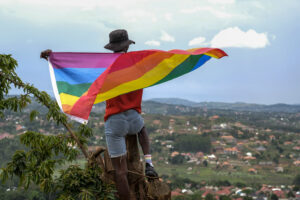
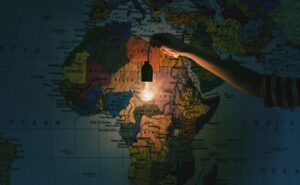





You need to be a supporter to comment.
There are currently no responses to this article.
Be the first to respond.